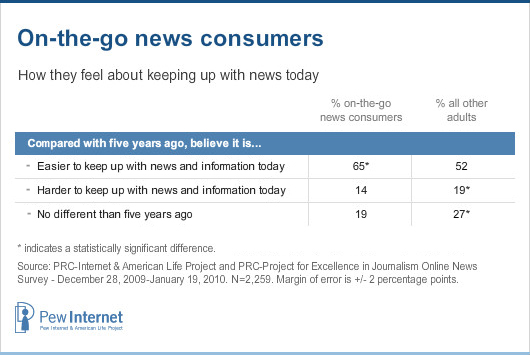Introduction
Mobile tech devices, such as laptops, cell phones, smartphones and other handheld devices, are dramatically changing the way Americans access information in their lives.4 Currently, 53% of adults access the internet wirelessly either through a laptop or a cell phone, BlackBerry or other handheld device. Pew Internet studies have shown that wireless internet users are different from other online adults in important ways: they are 36% more likely than wired internet users to access the internet on a given day, and they engage in virtually all online activities (including email, social networking, and blogging) at higher rates than other internet users.
To understand the impact of wireless mobility on news consumption, the current survey asked owners of cell phones, BlackBerries and other handheld devices about different ways they might get news on the go. Overall, 26% of American adults say they get some form of news via cell phone – that amounts to 33% of adult cell phone owners and 88% of adults who have mobile internet. To arrive at that figure we asked the 80% of American adults who own cell phones if they access the internet or email by phone; some 37% say they do. Among this subgroup of internet-using mobile phone users, we found that the vast majority get some kind of news online:
- 72% check weather reports on their cell
- 68% get news and current events information on their cell
- 49% have downloaded an application that allows them to access news, weather, sports, or other information on their cell
- 44% check sports scores and related information on their cell
- 35% check traffic information on their cell
- 32% get financial information or updates
- 31% get news alerts sent by text or email to their phones
- 88% say yes to at least one of the above
Overall, cell users under age 50 are almost three times as likely as their older counterparts to get news on the go (43% v. 15%), and they engage in all cell-based news consumption activities at higher rates than older cell phone users.

Who are on-the-go news consumers?
The typical on-the-go news consumer is a white male, age 34, who has graduated from college and is employed full-time. Given their younger profile, it is not surprising that 40% of this group are parents of young children (compared with 30% of the general adult population), and 32% have never been married. One in three (32%) live in households with incomes of $75,000 or more. As a subset of the broader mobile internet population, on-the-go news consumers reflect many of their characteristics (see table below).
Not surprisingly, on-the-go news consumers maximize their cell phone use. They are 67% more likely than other cell phone users to text message, more than twice as likely to take pictures with their phones, and four times as likely to use their phones to instant message. They are also especially heavy internet users—80% of this on-the-go group are online on a given day, compared with just 67% of other internet users—and they engage in activities such as blogging (20% v. 11%), using social networking sites (73% v. 48%), and using status update sites like Twitter (29% v. 14%) at significantly higher rates than other internet users.

Attitudes and behaviors of on-the-go news consumers
The news consumption of this on-the-go group, in addition to being mobile, is voracious. While they are no more likely than other adults to say they follow the news “all or most of the time,” they utilize a greater number of news platforms. More than half of on-the-go news consumers (55%) use at least 4 different news platforms on a typical day. They are 50% more likely than other adults to read the print version of a national newspaper (23% of on-the-go v. 15% all other adults). The only news platform they are less likely than other adults to use on a typical day is their local television news, and this difference is only slight.
Moreover, the majority of on-the-go news consumers (62%) get news from at least three different online news sources on a typical day, including one quarter (25%) who use at least six different online sources in a typical day. These mobile newsies use each of the 13 different types of online news sources asked about at higher rates than other online news consumers. Asked how many websites they routinely rely on for news and information, 60% say they use 2-5 and another 16% say they use 6 or more.
In addition to using multiple news platforms, on-the-go news consumers are interested in a wide variety of news topics. With the exception of health and medicine, they are more likely than other online adults to use the internet to get news or information about every one of the twelve topics asked about in the survey. Half of on-the-go news consumers (49%) use the internet to get information about at least nine of those twelve topics, compared with 35% of other internet users.

On-the-go news consumers who follow the news at least now and then tend to put the information they find online to practical use. In this sense, they are the most instrumental news consumers, twice as likely as other regular news consumers to say they need to follow the news for their jobs (30% v. 15%). They are also slightly more likely than others to say that they find information in the news that improves their lives (66% v. 59%) and that they enjoy talking about the news with their friends and family (77% v. 70%).

It is no surprise that two out of three mobile news consumers (65%) say that it is easier to keep up with news and information today than it was five years ago. Only 14% of this group believes it is harder to keep up with news today. On-the-go news consumers are slightly more likely than other adults, however, to see bias in most news sources today (78% v. 69%) and to say the statement “I only follow news about specific topics that interest me” describes them very well (34% v. 26%).
On-the-go news consumers are excited about the advanced features of today’s online news sites, and are consistently more likely than other online news consumers to say features such as interactive material, links to related information, being able to comment on stories, and being able to easily share content are important to them. They are particularly more likely to value portal news sites and being able to easily share content as the most important features they look for in a news site.

In addition to seeking out advanced features in their news sites, on-the-go consumers are also especially likely to contribute material or actively share it with others. Almost half of on-the-go news consumers (46%) are what we term “news participators”– a group that is examined more fully in Part 6 of this report. News participators engage in one of the following activities:
- Tagging or categorizing online news content
- Contributing their own article, opinion piece, picture or video to an online news site
- Commenting on a news story or blog they read online
- Posting a link to a news story or blog on a social networking site
- Using Twitter to post or re-tweet a news story or blog
By comparison, 31% of all other internet users (those who are not on-the-go mobile news consumers) are news participators.
Mobile news consumers “on alert”
Within this active group of on-the-go news consumers is a super-intense group of newsies—those who not only use their phones to get news, but also have news alerts and updates sent to their phones. They make up 35% of the on-the-go news consumer population, and represent 13% of all online news consumers and 12% of all internet users.
Among this group of newsies, seven in ten (70%) say they follow the news all or most of the time (compared with 56% of all adults), 71% go online to get news daily or almost daily, and 56% say they get news forwarded to them everyday or almost everyday. Half of those (50%) say they read most or all of what is forwarded to them.
Compared with other on-the-go news consumers, this on-alert group is even more likely to:
- Read the print version of a local newspaper (55% v. 43% of other on-the-go news consumers)
- Watch a national television news broadcast (80% v. 67%)
- Listen to a radio news program (63% v. 52%)
- Enjoy talking with friends and family about what’s going on in the world (83% v. 66%)
- Feel they have a social or civic obligation to stay informed (80% v. 61%)
- Find information in the news that improves their lives (79% v. 53%)
- Agree with the statement “the amount of news and information available today is overwhelming” (76% v. 64%)
- Agree with the statement “Major news organizations today do a good job covering all of the important news stories and subjects that matter to me” (77% v. 58%)
- Say they do not rely on other people to keep them informed (59% v. 45%)
- Enjoy coming across news and topics they have not thought about before (42% v. 33%).
- Go online specifically to get news daily or almost daily (71% v. 53%)
And once online, this group of on-alert news consumers is more likely than other mobile news consumers to:
- Use the internet to get news about business or finance (77% v. 67%)
- Visit the website of a national or local newspaper (55% v. 37%), TV news organization (68% v. 44%), radio news organization (28% v. 13%), or international news organization (30% v. 18%)
- Visit a website that specializes in a particular topic like health, politics or entertainment (54% v. 38%)
- Get a news podcast (26% v.15%)
- Visit a website that offers a mix of news and commentary, such as the Drudge Report or Huffington Post (29% v. 17%)
- Follow a news organization or individual journalist on a social networking site (27% v. 13%)
- Routinely rely on six or more websites for news (23% v. 13%)
- Have a favorite news source online (44% v. 32%).
- Visit their favorite online news source several times a day (23% v. 10%).
- Say that being able to follow a news site on a social networking site is important to them (43% v. 28%)
- Say that being able to easily share news content is important to them (61% v. 45%)
- Often click on links to related material (36% v. 25%)
- Watch an online feed of live or breaking events (89% v. 61%) or a video of a news story that happened in the past (85% v. 70%)
- Participate in online news creation (57% v. 40%)




